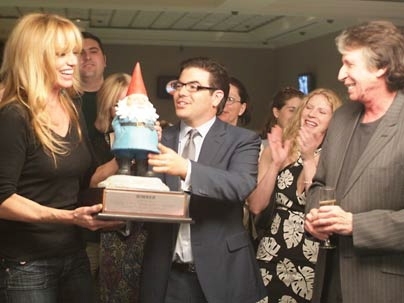What can a poker expert do to sharpen his image?
MIT alumnus Edward R. Miller placed his bet on the television makeover show "Queer Eye for the Straight Guy" -- and it looks as if he's played his cards right.
The former professional player and poker how-to author received the royal treatment from the Fab 5, as the show's co-hosts are known, at his home in Las Vegas.
The episode, which will air Tuesday, June 20, at 10 p.m. on Bravo, comes just in time for this month's release of Miller's third book, "No Limit Hold 'em: Theory and Practice" (Two Plus Two Publishing), co-authored with David Sklansky.
"The point of the makeover was to get me to a position where I would be more attractive to the general media," said Miller (S.B. 2000). He said he hoped to gain poise and polish that will translate into a wider audience for his books, which are aimed at serious players who want to make a living at poker.
In the episode, "Queer Eye" sweeps into Miller's life and transforms him, his apartment and his self-promotion skills. In return, Miller schools co-host and interior decorator Thom Filicia in Texas hold 'em strategy for a celebrity poker mini-tournament at Caesar's Palace with Susan Anton, Penn Jillette, David Brenner and George Wallace. The event, which Miller emcees, benefits a Hurricane Katrina-related charity -- a cause significant to him. Both of Miller's parents lost their New Orleans homes in the storm.
The Fab 5 turn Miller's book-clogged, unfashionable living room into a hip, comfortable space. And, Miller received an hour-long shaving lesson, pointers for an interview with "All In" poker magazine arranged by the show, and instruction on how to pair wine with the spicy ethnic foods he and his wife, Elaine Vigneault, enjoy.
MIT skills at play
Miller, who earned degrees in physics and electrical engineering and computer science at MIT, worked for Microsoft after graduating but quickly tired of corporate life and found solace in the challenge of teaching himself poker. He spent about six months learning -- and losing -- before it all clicked. He won around $6,000 two months in a row, then promptly quit his job and moved to Sin City to pursue the game full time.
After a year of professional play, Miller modified his career goals. "Once I saw how hot poker was getting, I decided to make the transition from professional player to poker businessperson," he said.
Miller said MIT helped him develop the analytical and communication skills he needed to write about the logic, math and probability inherent in the game. "Most people who write poker books aren't as technically minded, so sometimes they have trouble expressing what they think about and what they do in a precise way," he said. "My MIT education has taught me to think logically about poker, it's taught me to think from a technical perspective, and it's much easier to communicate that way with other people."
Nowadays, Miller plays medium stakes games about five-10 hours a week. At his peak, when playing 40-60 hours a week, he could win (or lose) as much as $5,000 a day.
So what's this poker guru's best advice for beginners? Factor losing into your education. "Poker is a lot more complex than it looks, and it's going to take you a long time to become a winner," he said. "Play at stakes where you can lose for six months and not really worry too much about the money."






